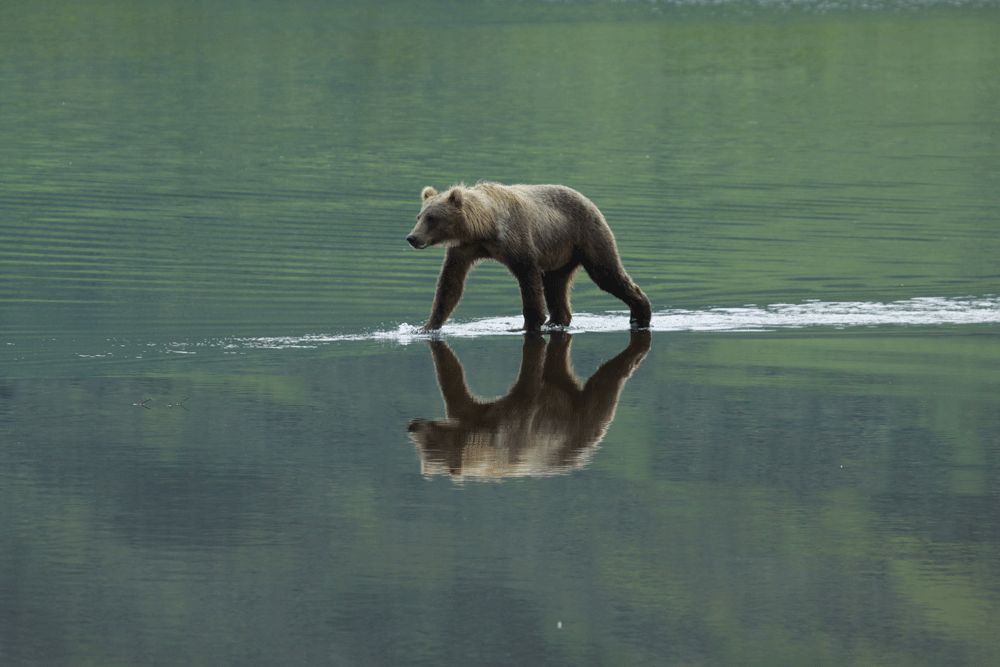 Once again, my wife Rika, my brother in-law Piet and I are on the verge of donning our casual attire. We are leaving behind the hysterical pressures, the interferences, the television addictions, the pettiness, the financial worries, and the decadence of the western civilization behind, and are going to put on our paradisiacal costume.
Once again, my wife Rika, my brother in-law Piet and I are on the verge of donning our casual attire. We are leaving behind the hysterical pressures, the interferences, the television addictions, the pettiness, the financial worries, and the decadence of the western civilization behind, and are going to put on our paradisiacal costume.
Somewhere in the north west of the Alaskan island Kodiak we allow ourselves be dropped off by a bush pilot on the banks of the Karluk Lake, by the source of the Karluk River, or on the banks of the Frazer Lake, in the middle of an untamed wilderness, to be able to live for a while with the biggest bears on earth
For us, the middle of an untamed wilderness means nature that has been untouched by man, which is also cut-off from every contact with the outside world. No mobile telephones, radio or television. No sat phone or Mari phone. Our living quarters are tents made up of wooden cabins that stand on the edge of the lake.
These 13 mile long lakes are more like inland seas. On Kodiak island the south westerly winds are actually the storm winds that blow very frequently in September. The lake functions as a storm catalyst that seems only to worsen the storms. Our tents are pitched on the gravelly grass, just on the north westerly side of the lake. Without any protection, standing completely in the open and totally subjected to the changing weather conditions. Luckily, we are standing high enough so that the heavy waves can’t flush out our small hiding places. The cabins are more spacious, however …… lack any form of western comfort.

Living apart … together from Rika Woodhouse on Vimeo.
In this wilderness we are going to look for Kodiak bears. As a result of their island isolation they have evolved, over the past thousands of years, into the largest brown bears on earth. They have been put into this unique category through their over indulgence in food, especially the salmon. We want to get to know more about the behaviours of the Kodiak bears and especially the course of their lifestyle. Our first short trip to this area was back in 2007. This time we are planning to get to know the bear population more intensively.
Bears are omnivores, but have been categorised by some biologists as carnivorous beasts of prey.
Certainly, bears are capable of attacking, killing and eating all deer’s that live in North America. Humans also fall under the animal category. The bears eating pattern is not really specifically directed towards the consummation of meat. Eating carrots, plants, fruits, grasses and fish is more important. Also, small young animals are on the menu. Humans are down on their priority list. Nevertheless, one has to be carefully with these large and extremely powerful bears. A Kodiak Grizzly can easily decapitate a deer with one sweep of his claw. Our necks are certainly not stronger than that of a Sitka deer.
We are sharing our wilderness encounter with Rudy de Bock, a Belgian “Bear Watcher” who, for nearly two decades now, bivouacs for a few months every year between the bears on Kodiak Island and Katmai. Consider him as a “Bear person”, who fully realises that the bears tolerate him as he is. They will never become friends. Timothy Treadwell, the Grizzly Man, tried it and paid for it with his life. Even so, just like Timothy, we find ourselves in the middle of these most dangerous grizzlies, and have, just like Timothy, no sufficient protection.
Our tents have not been safeguarded with an electric fence. We do not have any guns with us. We only have pepper spray and flash lights that can help us scare the bears away.
The encounter with the Kodiak bears, has given us besides the tingling challenge, an inward feeling of intense suspense. We are going for it, and you can look on and sympathize.
Harry and Rika




















































